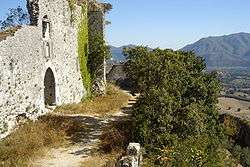Alvito
Alvito may refer to:
Places

Alvito, Portugal
Alvito (Portuguese pronunciation: [ɐɫˈvitu]) is a town and a municipality in Beja District in Portugal. The population in 2011 was 2,504, in an area of 264.85 km².
The current mayor is António João Feio Valério.
History
The Alvito region has been inhabited since the Neolithic, and during the period of Roman domination several villae were established nearby, later occupied by Visigoths and Moors. During the Reconquista, Alvito was conquered by the Portuguese in 1234, being later (1251) donated by King Afonso III to Estêvão Anes, chancellor of the kingdom, who promoted the settlement of the area.
The village gained a foral (letter of feudal rights) in 1280, confirmed by King Dinis I in 1283. In 1296 an annual fair was established, attesting the rapid development of the region. In 1387, King John I donated Alvito to knight Diogo Lobo in exchange for his services in the decisive Battle of Aljubarrota (1385), and in 1475 the title of Baron was granted to the rulers of Alvito.
The 15th and 16th centuries were a time of strong economic and populational development of Alvito, which reached 1700 inhabitants in 1527. The Castle of Alvito was rebuilt between 1494 and 1504, and its architecture and decoration show an interesting mix of Manueline (Portuguese late Gothic) and Mudéjar (Arab-influenced) styles, typical of the Alentejo region. Also the main church (matriz) of Alvito, in a mix of Manueline and early Renaissance styles, dates from the early 16th century.

Alvito, Lazio
Alvito is a town and comune in central Italy, in the province of Frosinone, south of Rome in the Lazio region. Its home to one of the oldest Italian castles. Its territory is included in the Abruzzo, Lazio and Molise National Park.
History
Alvito was called in antiquity "Albitum", and was later a possession of the Abbey of Montecassino, and then of the Counts of Aquino and the Cantelmo family.
Alvito was the seat of a Duchy, created in 1454, on the boundary of the Kingdom of Naples (later, Kingdom of the Two Sicilies). Alvito, together with Sora, remained faithful to the Angevine line during the conquest of Alfonso V of Aragon, being conquered by the Aragonese only in 1496. Later it was a possession of the Gallio family.
Main sights
The village is articulated in three district urban nuclei that include: la Rocca (fortress), il Peschio, il Borgo Basso, contained in long town-walls still well preserved here and there. The Palazzo Ducale (or Palazzo Gallio, Ducal Palace), built in Renaissance style by Tolomeo Gallio in the late 16th-early 17th centuries, is located on the main road of the Basso Suburb, constituting the true nucleus of the present village. A little bit forward, on the left hand, a short small road goes uphill to the Church of S. Teresa. The Church is of baroque style, with a high portal.
Podcasts:

-
by Eluveitie
-
by Eluveitie
-
by Eluveitie
-
by Eluveitie
-
by Eluveitie
-
by Eluveitie
-
by Eluveitie
-
by Eluveitie
-
by Eluveitie
-
by Eluveitie
-
by Eluveitie
-
by Eluveitie
-
by Eluveitie
-
by Eluveitie
-
by Eluveitie
-
by Eluveitie
-
by Eluveitie
-
by Eluveitie
-
by Eluveitie
-
by Eluveitie
-
by Eluveitie
-
by Eluveitie
-
by Eluveitie
-
by Eluveitie
-
by Eluveitie
-
by Eluveitie
-
by Eluveitie
-
by Eluveitie
-
by Eluveitie
-
by Eluveitie
-
by Eluveitie
-
by Eluveitie
-
by Eluveitie
-
by Eluveitie
-
by Eluveitie
-
by Eluveitie
-
by Eluveitie
-
by Eluveitie
-
by Eluveitie
-
by Eluveitie
-
by Eluveitie
-
by Eluveitie
-
by Eluveitie
-
by Eluveitie
-
by Eluveitie
-
by Eluveitie
-
by Eluveitie
-
by Eluveitie
-
by Eluveitie
-
by Eluveitie
Grey Sublime Archon (Live At Metal Camp 2008)
by: EluveitieI raise my hand against ye, thief!
For we're accustomed to receive,
Not to give hostages
Hear these words! deeds are overt!
As chaos evolves
In worthless lies
A crucial congress
At saônes banks
Gray Sublime Archon I've been called
Through all these years I bore up
Now may we all stay the course
This day
I raise my hand against it all
I question now, did I fail?
Or retain our dignity
And shelter of this defilement?
As chaos evolves
In worthless lies
A crucial congress
At saônes banks
Gray Sublime Archon I've been called
Through all these years I bore up
Now may we all stay the course
This day
A crucial congress
At saônes banks
As chaos evolves
In worthless lies
Gray Sublime Archon I've been called
Through all these years I bore up
Now may we all stay the course
